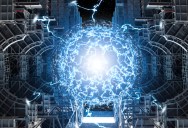Korea’s “Artificial Sun” Reactor Has Topped 100 Million Degrees

Scientists and researchers are keen to be able to generate energy that mimics the sun to power nuclear reactors here on Earth.
Now, Korea’s reactor has set a new world record and brought us one step closer to making that goal a reality.
The achievement was made using the Korea Superconducting Tokamak Advanced Research device (KSTAR).
The plasma temperature of 100 million degrees Celsius lasted for 48 seconds, and is seven times as hot as the Sun’s core.

The theory behind fusion energy is simple. Scientists aim to fuse atoms together inside a reactor and generate a net positive amount of safe and pollution-free energy.
In practice, though, we’ve run into more than a couple of stumbling blocks.
That said, this latest record makes teams at the Korean Institute of Fusion Energy (KFE) optimistic.
“This will be of great help to secure the predicted performance in ITER operation in time and to advance the commercialization of fusion energy.”
The ITER is the world’s largest nuclear reactor, currently under construction in southern France.

Their goal is to eventually sustain the temperatures for 300 seconds, which would allow researchers to scale up operations.
Other tokamak reactors have been achieving breakthroughs of their own.
Chinese scientists confined plasma for 403 seconds inside their Experimental Advanced Superconducting Tokamak.
In the UK, researchers produced 69 megajoules of energy, which is enough to power around 12,000 homes.

Scientists at the National Ignition Facility’s laser-based reactor say they’ve gotten twice the amount of energy out that they put in – though this technology differs from conventional tokamak designs quite a bit.
The research seems to be building to something, and according to researchers, that something is a fusion energy revolution that could replace fission reactors once and for all.
The completion of the facility in France, hopefully in 2025, will push those goals along at a faster pace.
Only time will tell, but it does seem as though scientists are on the right track.
If you think that’s impressive, check out this story about a “goldmine” of lithium that was found in the U.S. that could completely change the EV battery game.

Sign up to get our BEST stories of the week straight to your inbox.




